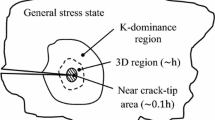Abstract
In the current paper a new method for calculating the stress intensity factor from isochromatic data is proposed. The method is based on the calculation of a map of the retardation using only the light- and dark-field images of a crack from a circular polariscope. The experimental retardation is compared with the theoretical one predicted by Westergaard’s model using between 700 and 800 data points in an array around the crack tip region. In this way, the necessity of unwrapping and calibrating the isochromatic fringe order distribution is avoided and a large potential source of error is eliminated. Subsequently, KI, KII and σox are inferred by minimizing an error function. To show the potential and efficacy of the method, K values have been obtained from photoelastic images captured during fatigue tests conducted in a polycarbonate Center-Cracked-Tension (CCT) specimen. Results show an excellent level of agreement with those predicted from theory, highlighting the potential of the proposed methodology.








Similar content being viewed by others
References
Post D (1954) Photoelastic stress analysis for an edge crack in a tensile field. Proc SESA 12(1):99–116
Wells A, Post D (1958) Dynamic stress distribution surrounding a running crack- a photoelastic analysis. Proc SESA 16(1):69–92
Irwin GR (1958) Discussion of the paper: dynamic stress distribution surrounding a running crack- a photoelastic analysis. Proc SESA 16(1):93–96
Smith CW (1973) Use of 3D photoelasticity in fracture mechanics. Exp Mech 13:539–544
Sanford RJ, Dally JW (1979) A general method for determining the mixed mode stress intensity factor form isochromatic fringe patterns. Eng Fract Mech 11:621–683
Ramesh K, Gupta S, Kelkar AA (1997) Evaluation of stress field parameters in fracture mechanics by photoelasticity—revisited. Eng Fract Mech 56(1):25–45
Dally JM, Chen HY (1990) Determination of mixed-mode stress-intensity factor KI and KII for a subsurface crack near a concentrated force. Exp Mech 30(2):124–129
Patterson EA, Gungor S (1997) A photoelastic study of an angle crack specimen subject to mixed mode I–III displacements. Eng Fract Mech 56(6):767–778
Yoneyama S, Sakaue K, Kikuta H, Takashi M (2008) Observation of stress field around an oscillating crack tip in a quenched thin glass plate. Exp Mech 48:367–374
Diaz FA, Patterson EA, Tomlinson RA, Yates JR (2004) Measuring stress intensity factors during fatigue crack growth using thermoelasticity. Fatigue Fract Eng Mater Struct 27(7):571–584
Diaz FA, Yates JR, Patterson EA (2004) Some improvements in the analysis of fatigue cracks using thermoelasticity. Int J Fatigue 26(4):365–376
Lopez-Crespo P, Burguete RL, Patterson EA, Shterenlikht A, Withers PJ, Yates JR. Study of a crack at a fastener hole by digital image correlation. Experimental Mechanics, in press
Christopher CJ, James MN, Patterson EA, Tee KF (2008) A quantitative evaluation of fatigue crack shielding forces using photoelasticity. Engineering Fracture Mechanics, doi:10.1016/j.engfracmech.2008.03.013.
Nurse AD, Patterson EA (1993) Determination of predominantly mode II stress intensity factor from isochromatic data. Fatigue Fract Eng Mater Struct 16(12):1339–1354
Patterson EA (2002) Digital photoelasticity: principles practice and potential. Strain 38:27–39
Wang ZF, Patterson EA (1995) Use of phase-stepping with demodulation and fuzzy sets for birefringence measurement. Opt Lasers Eng 22:91–104
Ewalds HL, Wanhill RJH (1989) Fracture mechanics. Edward Arnold, Netherlands
Westergaard HM (1939) Bearing pressures and cracks. J Appl Mech 6:49–53
Williams ML (1957) On the stress distribution at the base of a stationary crack. J Appl Mech 24:109–114
Muskhelishvili NI (1953) Some basic problems of the mathematical theory of elasticity, 3rd edn. Noordhoff Ltd., Groningen, Holland
Ramesh K (2000) Digital photoelasticity Advanced techniques and applications. Springer, Berlin
Nelder JA, Mead R (1965) A simplex method for function minimization. Comput J 7:308–313
Pacey MN, James MN, Patterson EA (2005) A new photoelastic model for studying fatigue crack closure. Exp Mech 45(1):42–52
Sherry AH, France CC, Goldthorpe MR (1995) Compendium of T-stress solutions for two an three dimensional cracked geometries, Vol. Fatigue Fract Eng Mater Struct 18(1):141–155
Pacey MN, James MN, Wei LW, Patterson EA (2003) Characterization of plasticity-induced closure-crack flank contact force versus plastic enclave. Eng Fract Mech 70(17):2473–2487
Lesniak JR, Zhang SJ, Patterson EA (2004) The design and evaluation of the poleidoscope: a novel digital polariscope. Exp Mech 44(2):128–135
Acknowledgements
This work has been conducted with the financial support of the Spanish Ministerio de Educación y Ciencia through the research project MAT2006-09350 del Plan Nacional de I + D. The authors also gratefully acknowledge the support provided by the research mobility program José Castillejo. The generosity of the Department of Mechanical Engineering at Michigan State University in providing laboratory facilities is gratefully acknowledged.
Author information
Authors and Affiliations
Corresponding author
Rights and permissions
About this article
Cite this article
Diaz, F.A., Patterson, E.A. & Siegmann, P. A Novel Experimental Approach for Calculating Stress Intensity Factors from Isochromatic Data. Exp Mech 50, 273–281 (2010). https://doi.org/10.1007/s11340-009-9282-1
Received:
Accepted:
Published:
Issue Date:
DOI: https://doi.org/10.1007/s11340-009-9282-1




